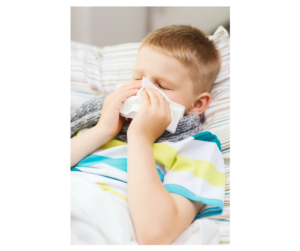PANDAS or PANS is an acronym that stands for Pediatric Autoimmune Neuropsychiatric Disorders Associated with Streptococcal Infections. In 2010, PANDAS became PANS, which is the current proper term for it, so you may hear both.
The onset of PANS symptoms come often after a Streptococcal infection, also called Strep. After Strep. they may get tonsillitis. The onset can also be seen after an insult to the immune system that may trigger inflammation. It is known to become apparent after the H1N1 influenza vaccination which increases its likelihood. Genetically, those with mitochondrial deficiency are also more susceptible. Also look for excessive fatigue. They may even have mononucleosis (mono). Other infections that are known to trigger PANS can be mold, Lyme disease, and Epstein Barr virus, which is what causes mononucleosis. We commonly may see mycoplasma infections such as a sore throat, or a respiratory infection. To add to the uncertainties, there may not always be symptoms of infections prior to the noting of the onset of the symptoms of PANS.
Parents may notice a sudden onset of symptoms such as obsessive compulsive disorder (OCD), or tiks. Tiks can be motor tiks where their body jerks rapidly, (not wiggling), or vocal tiks. Additional symptoms include separation anxiety, a decline in school such as in their reading and math abilities, simplified language, baby talk, bed wetting, and increased urination, aggression, and anxiety with stress.
PANS predisposes one to the symptoms of autism. Autism being a co diagnosis. Instead of a fever their brain will be effected, and thus, their psychology. PANS effects the immune system which is commonly weak in those with autism, so they are a higher percentage.
The onset of PANS is most common among children between the ages of three and eleven. It is noticed more around the age of seven or eight years old because of violent stimming. From ages three to five there may just be hyperactivity. Under the age of three it mimics the symptoms of autism.
Treatment for PANS
It is important with autism not to boost the immune system. It may already be overactive and likely is with PANS. For this reason we need to be sure our treatment regulates the immune system. Regulating the immune system and treating infections with the right diet and the right supplements that also reduce inflammation are essential.
To learn how to detoxify slowly and cover all of the coinfections both safely and naturally, please watch my free webinar now here.
The goal is to keep the child stable. Triggers that contribute to a PANS flare-up include Streptococcal infections, mold biotoxins, Lyme, rapid die-off reactions from detoxification that is going too fast for the child’s body to keep up with, and toxic exposure.
Underlying toxins, pathogens and coinfections cause inflammation on the brain which causes the damage which creates the symptoms of autism. These symptoms in your child can range from inability to focus and learn to their full potential, sleep disorders, irritability and even aggression.
The good news is it is reversible. I have utilized this successfully with my own son even after I was told it was not possible, but I forged on because of my love for him.
I now have over 18 years of autism research to share with you to help simplify the process and get you real results. We work with all of them in my programs, naturally.
Need help knowing what to do to make your child's life a better one?
As a mother of an autistic child, I understand the worry, frustration, and fear that comes with the diagnosis... and the hopelessness that can stem from failed solutions. Please hear me when I say:
You do not have to settle for behavioral therapies and medications that “manage” symptoms (at best) for the rest of time. There is another way.
In the Naturally Recovering Autism Membership Program, I break down everything A-Z that worked for my son—and thousands of my clients' children—so you can finally, FINALLY, celebrate a solution that works.
This is for informational purposes only and is not meant to diagnose or treat. Every child’s level of recovery is different. No two people are the same. It is never implied that all children will have the same outcome. Results are all based on individual biology and the work that is done. This process takes time and various steps, effort and resources need to be weighed. Our programs are intended to help you become more knowledgeable and guide you to help bring your child a better quality of life, whatever that may be. We want to help by giving great content, direction and strategies that move you forward. Nothing on this page or any of our websites is a promise or guarantee of results or future outcomes. The results on this page and any of our websites are not typical or promised. In fact, there will be people who purchase this and other programs and never put the work into implementing the strategies taught and therefore will achieve little to no results. Our more detailed earnings disclaimer, privacy policy, and terms and conditions for this program and website can be accessed via the links below. We hold ourselves (and you) to a high standard of integrity. We are cheering you on every step of the way.













I was told that my son had pandas. I was referred to a doctor specialized in treating Pandas in Connecticut. We started treatments of antibiotics for 1 year along with IVIG treatments but when I took my son to another doctor in Paton who had some concerns about the IVIG treatments did some testing of his own and stating that the test results did not show or prove that my son ever had Pandad. I immediately stopped going to Connecticut for IVIG infusions because I did not see any change in my son’s health. However, I did believe that my son might have had pandas at some time because he had numerous streptococcus infections when he was younger between the ages mentioned!
Yes, Ann, it is often missed in diagnosis. There are different kinds too such as beta/gamma strep, and alpha strep that gets into the sinuses and is hard to get rid of due to biofilm. Please see my podcast interview, Comorbid Symptoms of Autism-Lyme, Mold Biotoxins and More.
OMG! My son has it from he is 1.5 years and the only way we are offered to to treat it is to cut tonziles out. I hope diet and Karen’s program will help to treat it to naturally.
Hi Laura,
The tonsils are a carrier of the strep. We will be discussing this in my podcast interview (noted in my last two replies here). The pieces of the program are essential, as well as treating the comorbid symptoms with the right remedies.
My son was diagnosed with PANDAS 4 years ago. It was when he had an active strep infection. Antibiotics and IVIG were recommended. Because it would not necessarily get rid of the PANDAS, we did not pursue treatment. He has a bad reaction to a flu vaccine when he was 20 months old. I believe it caused inflammation in his body because it changed his personality completely. He hasn’t been the same since. This was very informative. I’m not sure where to go next with this.
Hi Diane,
It’s great that they have found the strep. It often gets missed. Yes, an inflammation trigger, such as the flu shot, is common. Please see my response to Laurie here about great options that are coming soon to help you with this. Be sure you are on my email list to be notified of new podcast releases. Sign up at the bottom of any podcast page to “never miss an episode” and you will be sent an email when the podcast about this is released. we have answers for you.
My daughter went through a really bad time with tonsils at age 2.Before she was diagnosed with autism,we were having a really hard time not knowing why she was behaving the way she was and every night she would be a a deep sleep and would wake up throwing up and gasping for air.I finally got her doctor to send us to a specialist and he said her tonsils were choking her every night when her body relaxed,so we had them removed immediately,and she did start to sleep longer,but still not all night,and the tantrums were so frequent,we couldn’t go places,being around people stressed her out to much,all we asked for her to be tested .We knew something wasn’t right.so at age 3 she was diagnosed with Autism.we had just bought a house in the country and our cat would go in and out and he must have brought in a tic.Our daughter had a spit on her back and we thought it was a mosquito bite and asked us to itch and after a couple days it turned into a bullseye we went to the doctors and she now has Lyme disease they treated her with antibiotics,but she hurts and catches every st ran of illness it seems and when she’s on antibiotics she seems angry.This has been an exhausting road.She almost 7 After researching I came across Karen and her new program.I feel there’s hope.I have always believed I could help her get better ,and now I feel more than sure.We adopted khloe at birth and she is an amazingly smart child,and we want her to have a wonderful life and we won’t stop until she does.I follow my gut and don’t stop until I get answers.I have had her on a gluten dairy free diet for a while and it has helped.I am ready to start the detoxifying with the zeolite that goes straight to the cells to remove the toxins .I also have her on a probiotic .I’m hoping we see improvement with her anxiety,and stoning.I wish you all a blessing
Hi Laurie,
Thanks for sharing this. It is so common for children with autism to have undiagnosed strep and Lyme. The symptoms can mimick each other. All of the pieces of the program are essential to the best outcome. I am so glad you are a member. For the co-morbid symptoms such as Lyme and strep I am talking to a natural medical doctor who has developed a way to treat many of these symptoms with herbal formulas that she has developed. She is still perfecting but is having great success. I will be releasing the interview with her on July 1, 2018. She asked that we wait to do the interview and give specifics until her research feels conclusive. Stay tuned!
Thank you for sharing. This is the first time I have seen someone describe the condition as a possible cause of ‘autism ‘. My son was typically developing until last fall with his first onset of PANS, age 4 1/2. I was lucky to have it identified early & he responded well to azythromiacin and follow up treatment with ND. He has had 2 subsequent flare ups which were very rapid & extreme. Also recovered about 95%.
I am a special ed teacher . I know autism. I am also a mother who knows her son. My kid is the cool kid at school. Super social & smart, no inhibitions whatsoever. Very athletic. A little extroverted jock. Zero autism symptoms. When affected by PANS he is anxious, obsessive, loses language & motor skills & executive functioning, & becomes extremely affected by sensory experiences (we know we’re in trouble when he starts smelling his legos). We are so lucky to have him recovered, but my heart breaks for some of my students who I think may actually be kids affected by PANS.
Can you cite any research or researchers who are studying the PANS-autism connection? I have tons of data & video footage of my son & i’m looking for someone to share it with in order to help other kids.
Thank for all the great insight you provide on your site!
Wow Jennifer, thank you for sharing this. It gives a great example of how much PANS can effect people and how it mimicks the symptoms of autism. I have given resources in my Lyme and mold guide (which also mimick autism and are often missed). This is under my interview with Dr. Dashore on these subjects, at https://naturallyrecoveringautism.com/2017/06/29/comorbid-symptoms-autism-lyme-mold-biotoxins-podcast/. We will be doing another interview and cover Strep and what can naturally be done for it in a late June release. At the bottom of the podcast pages there is a box to sign up to “never miss an episode”. This will assure that you will be notified via email when it is released. In the lyme and mold guide at the bottom of the Dr. Dashore interview there is a link for Dr. Stephen Bruhner. Type in “strep” in his search bar and it comes up with a natural herbal remedy to follow.
Other doctors to review are Dr. Rosario Trifiletti at, http://pandasinstitute.org/. Pubmed.com has some studies on “strep and autism”. Here’s one, https://www.ncbi.nlm.nih.gov/pubmed/24246964
Thank you for sharing and helping others who need to know. Please also refer people to my website for resources.
My child has autism with Severe ocd, tics, vocal tics and bed wetting. Panic attack, no strep infection. Please help me. Which lab test should be done. I am from India. I think he has autism with pans.
Never miss an episode about PANDAS or PANS
HI Maria,
Did you mean to sign up to never miss a podcast episode? If so, please go to any of the podcasts and scroll down to the bottom of the page under the video. You will see a sign up box there for this. It will add you to my email list to be notified when each new podcast episode is released. Thanks!
I suspect strep infections in my both children. 8 yrs old daughter became violent and aggressive, disconnected from learning, picky eating. My younger one has global developmental delay. In Australia where I can get them to be tested and what would be the treatment? Here drs do not want to deal w these issues. Thanks
Hi Mari,
You can get them tested using the links on this blog page. Hopefully, the doctor will utilize a good test and lab. For further knowledge you can get a skype consult with Dr. Jodie dashore. I interviewed her. You can watch the podcast interview by going to the podcast page here on this site. Please be sure you are aware of my autism Moms Mentor step by step online program. Parents are having success in over 30 countries with it now. You can learn all about it and enroll if you like on the home page here at naturallyrecoveringautism.com/
Hi, I have a son who was diagnosed with autism at age 2. Of course, as a parent, I always look into every way to treat his symptoms. The problem is, his “symptoms” will change in severity and are all over the place, that we never know which one we will see on a day-to-day basis. He is 12 and has become physically aggressive and verbally abusive. It comes out of nowhere. He is on psychiatric medications which have never seemed to help. He gets ABA therapy, which does not seem to help, either. From your criteria of PANS, it is a sudden onset of symptoms, right? But can it be triggered in infancy or even during pregnancy? Because he started showing signs of “autism” at four months old. We wouldn’t have noticed a sudden onset or regression of milestones like parents of a 4-year-old would see. We have noticed that he becomes calmer when he is on an antibiotic or when he has a slight fever. I would be interested to know if there has been studies about PANS/PANDAS onset in infancy or pregnancy.
Hi Tracey,
Yes, it is well known tha Strep, Lyme, parasites, heavy metals, viruses, and other infections are transferred in utero. Many kids are born with them and then there are environmental toxic insults that trigger and aggravate them. The inflammation causes more trouble. The gut directly affects the brain and the immune system so this is why the antibiotics help short term. There is pathogenic overgrowth there wreaking havoc. The antibiotics, long term, will cause more issues. They kill what is left of the good bacteria making them worse once the antibiotics are finished. You will need to begin the process by healing up the gut. It is just the beginning but it is very important. Please be sure to get my free download of the “7 foods to avoid” on the home page of this website, https://naturallyrecoveringautism.com.
Hi. Can the same symptoms of PANDAS occur other types of infection eg. threadworm or other parasites.
Hi Tracey,
Yes, parasites can create some of the same symptoms, as can Lyme. All are very common for kids with autism. This is why I address all of them in my online program. If interested, you can watch my new 4 stages to autism recovery webinar to learn all about it. It’s free at https://NaturallyRecoveringAutism.com/freeworkshop/